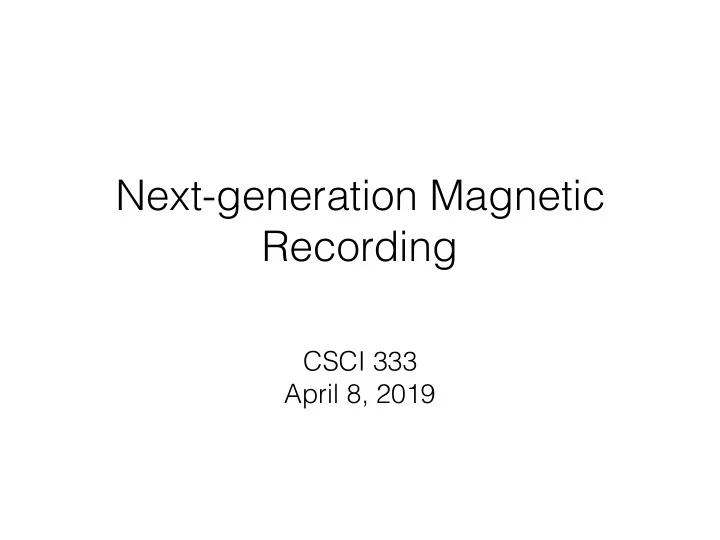

Next-generation Magnetic Recording CSCI 333 April 8, 2019
Last Class: SSDs • Interface: • Read from pages ‣ As many times as we want • Program (write to) pages ‣ Once -> then need to erase before rewriting ‣ Limited endurance -> need to wear level • Erase whole blocks ‣ Erasing is slow ‣ Need to perform GC -> migrate live data • FTLs wear many hats • L2P page translation, wear leveling, GC, ECC, …
This Class: “Spinning Rust” • (Abbreviated recap) Hard Disk Drives • Basic Design/Geometry • Performance characteristics • Shingled Magnetic Recording • Concepts and interface • Position in the storage stack • Other SMR Interfaces/Opportunities • Skylight • IMR
Next Class • Filters. Why shift schedule? • Hopefully inspire final project ideas • Original DAM model paper is rough… looking for more interesting/clear presentation of material • For next class: read the Bloom filter paper • Optionally read the quotient filter paper • Optionally read the cuckoo filter paper • Goals: • Understand/articulate problem(s) that filters solve • Describe the high-level design and parameters
Hard Disk Drives (HDDs) • High capacity, low cost • Predictable performance • “Unwritten contract”: LBAs near each other are more efficient to access than LBAs that are far away
HDDs Platters Sector (rotate) (unit of transfer) Tracks (concentric circles) Disk Head (seeks in/out)
Performance Observations • Setup (placing the disk head) is expensive O(10 ms) • seeking to target track • Up to a full rotational delay to locate target sector • Once the disk head is in place, data transfer is quite fast O(100s MiB/s)
HDD Effective Bandwidth (MB/sec) 2 6 2 4 2 2 2 0 2 − 2 2 13 2 16 2 19 2 22 2 25 2 28 Read size (bytes) Performance Goal : build a system where data is written sequentially (i.e., no random writes)
Keeping HDDs Relevant • HDDs compete on $/GiB, not performance • As capacity goes up, $/GiB down • Problem: ‣ Capacity gains traditionally result of reduced track width to increase density ‣ Physical limits restrict our ability to shrink tracks further • We’re stuck… unless?
[https://blog.seagate.com/craftsman-ship/hamr-next-leap-forward-now/]
Shingled Magnetic Recording (SMR) • Increases HDD density by overlapping tracks Perpendicular Magnetic Recording
Shingled Magnetic Recording (SMR) • Increases HDD density by overlapping tracks Perpendicular Magnetic Shingled Magnetic Recording Recording • Insight: Read head is more precise than write head • Technique: Overlap next track, but leave enough of “lower” track visible for safe reading
SMR Introduces Challenges • Writing data becomes harder • No random writes • No overwrites • Must garbage collect to reclaim space
No Random Writes If we don’t write to zones append-only , we could lose data
No Overwrites Must perform out-of-place updates , or suffer a read-modify-write of entire zone
Garbage Collection 1. Copy live data from source to destination 2. Reclaim old zone
Garbage Collection 1. Copy live data from source to destination 2. Reclaim old zone
Recall HDD Observations • Problem : Seeking is slow • Solution : perform large sequential I/Os Takeaway: HDD performance optimizations translate into SMR correctness
Simplified Storage Stack Application user space File System OS kernel data = read( LBA ), write( data , LBA ) Persistent SMR Storage Question: who enforces the SMR write constraints?
Drive Managed vs. Host Managed File System Read and write LBAs File System Read and write LBAs SMR Translation Layer (STL) Software Read LBAs, write to zones Firmware SMR SMR Translation Zoned Access Logic + Easy to Deploy + Flexible - Limited HW resources + Shares host resources
Zoned Block Commands Conventional zone(s) Sequential write required zones … • Conventional Zones • Random write capabilities of “normal” disks • Sequential-write-required zones • Query zone status • Append blocks to zone’s write pointer • Reset zone write pointer (reclaim space)
SMR Opportunities • Other SMR interfaces have been proposed • Caveat Scriptor • Configurable zone layouts (Flex) [Feldman ’18] • Interlaced Magnetic Recording (IMR) • Combines HAMR and overlapping tracks
Caveat Scriptor [Kadekodi ’15 HotStorage] Basic Idea: • Drive characteristics are exposed to the user • User can write anywhere, but data may be lost
Interlaced Magnetic Recording [Hwang ’16 Transactions on Magnetics] r Figure 3: Depiction of interlaced track recording R [Feldman ’18 ;login:]
Magnetic Recording (a) CMR (b) SMR (c) IMR Figure 1: Track layout for CMR, SMR, and IMR. [Wu ’18 HotStorage]
Open Questions • Translation layer design • Garbage collection schemes • Creating and using new interfaces • SMR-aware key-value stores • Integrating SMR maintenance with DS work
Let’s Think About Designs • What are our options? • Static or dynamic? • What do you think is done in practice (“Archive” DM-SMR drives available at big box stores)? • Skylight designed & performed benchmarks to tease out drive parameters
Recommend
More recommend